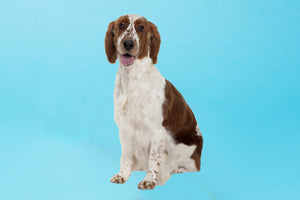
FREE UK DELIVERY ON ORDERS OVER £39.99

The Labradoodle is the ‘baby’ of the designer dog world and is thought to be the first real hybrid breed created. The man who developed them, Wally Conron, is quoted as being said he ‘created Frankenstein’s monster’. His negative view on the breed is thanks to the many health and behavioural issues that currently exist within the population.
Apparently, Wally was asked by a blind woman in Hawaii to create a guide dog that was hypoallergenic. He had the bright idea of breeding together the hard-working and highly trainable Labrador Retriever with the hypoallergenic and low-shedding Poodle. Wally laments the fact that ‘backyard’ breeders jumped on the band wagon and began to create these dogs in abundance, with little regard for their health or temperament.
Despite Wally’s reservations, many owners adore their Labradoodle and wouldn’t be without them. Though there is a great deal of variation from individual to individual, many are well-adjusted and sociable. Health issues are less common in those who have come from health-screened parents, so purchasing from a reputable breeder is a must.
The Labradoodle is tall and wooly; almost like a sheep. Their size will depend on which Poodle they have been bred with, but most are bred with the Standard Poodle and can reach heights of 61cm.
The coat of the Labradoodle is a solid colour and may be white, golden, apricot, brown, grey, red, silver or black.
Frustratingly, there is a range of personalities within the breed and some can be a little loopy. However, with adequate training and socialisation most can make excellent family pets. Affectionate, energetic and spirited; the Labradoodle is lots of fun to be around.
Given how much energy this dog has, owners need to be aware that they require lots of stimulation to keep them on an even keel. Neglecting to provide enough physical or mental stimulation is likely to result in a frustrated dog that can develop behavioural issues such as furniture chewing or separation anxiety.
Sadly, this hybrid dog is renowned for suffering from a number of health conditions. As no Kennel Club recognises them as a breed (no cross-breeds are currently recognised), it can be difficult for prospective owners to determine who is a reputable breeder and who is just in it for the money with no regard for the health of the litter.
How easy the Labradoodle is to train will depend on their individual temperament. Most are food-driven so try hard when a tasty treat or two is involved. They are relatively smart but can be easily distracted. Training is a great opportunity to challenge your dog mentally and to have a bit of fun at the same time.
While the coat of the Labradoodle does not shed much, it does need to be brushed a few times a week and professionally clipped regularly. Their pendulous ears can trap moisture inside and are prone to ear infections. Owners may wish to clean out their dog’s wax every 1-2 weeks to minimise the risk of infection.
This high energy dog enjoys being outside and will happily go for a 60 to 90 minute hike each day. Try to vary the routes to prevent boredom from setting in. Many Labradoodles are sociable and will enjoy having other canines alongside them from time to time.
As the Labradoodle is half Labrador, they are more prone than the average dog to become obese. This is thanks to their genetics but, despite this, it is not an inevitability that they will become over-weight. Owners should check their dog’s body condition score regularly and aim for a score of 4 out of 9. Keeping these dogs on the slim side of normal is especially important if they have joint disease such as hip dysplasia.
Consider a diet that targets your Labradoodle’s health. So, those who frequently suffer with diarrhoea may benefit from a diet such as Pooch & Mutt’s Health & Digestion. Similarly, those who have signs of joint disease would be good candidates for Pooch & Mutt’s Joint Care Diet.
You'll find a handy feeding calculator on every product page here at Pooch & Mutt to help you identify how much of our health led recipes are right for the age, size and weight of your dog.
Comments (0)
Leave a comment